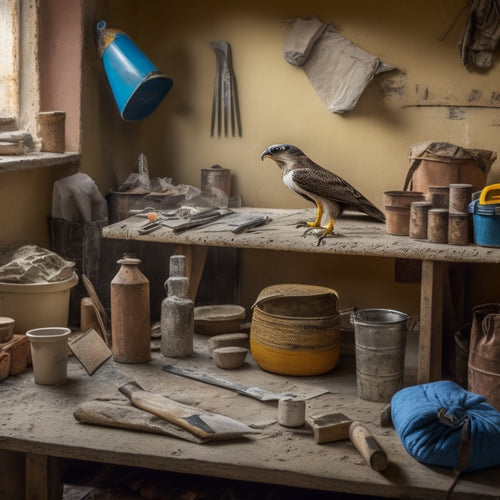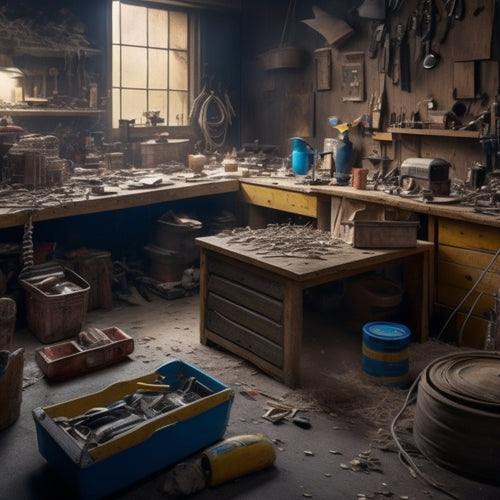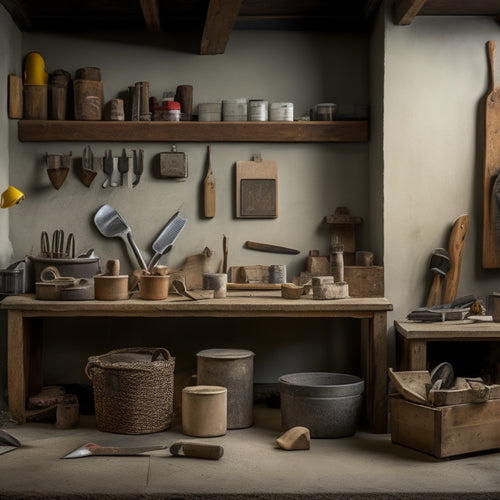
Protect Your Tools for Outdoor Renovation Success
Share
To guarantee outdoor renovation success, you need to protect your tool investment by understanding warranty and support options, extended protection, and maintenance best practices. Manufacturers offer guarantees that provide repair or replacement options, but consider third-party insurance plans for customized coverage solutions. Prioritize tool maintenance by cleaning, inspecting, and storing tools properly to extend their lifespan. Implement security measures to prevent theft and loss, and budget for replacement costs by accounting for tool quality and potential failures. By taking these steps, you'll be well on your way to safeguarding your tools and setting your project up for success - and there's more to investigate in this key area.
Key Takeaways
- Investigate warranty and support options for outdoor tools to ensure reliability and protection for renovation projects.
- Consider extended protection and insurance plans that offer tailored coverage options for tools, including theft, damage, and liability protection.
- Implement tool maintenance and repair tips, such as cleaning and storing tools properly, to extend their lifespan and avoid costly repairs.
- Prevent tool theft and loss by designating secure storage areas, marking tools with identifiable information, and keeping an inventory of tools.
- Budget for tool replacement costs by accounting for tool quality, potential failures, and overall project expenses.
Tool Warranty and Support Options
Investigate your tool warranty and support options before commencing on an outdoor renovation project.
You'll want to guarantee you're covered in case your tools fail or malfunction during the project. Understanding your warranty terms will give you peace of mind and protect your investment.
Check the manufacturer's warranty period, which typically ranges from one to five years. Some warranties may offer extended coverage for specific parts or components.
Take note of the warranty's limitations and exclusions, such as misuse or normal wear and tear. This will help you avoid unnecessary warranty claims.
Proper tool maintenance is essential for extending tool longevity. Regularly clean and store your tools to prevent damage.
Follow the manufacturer's guidelines for maintenance and repair to avoid voiding your warranty. If you need to make a warranty claim, have your proof of purchase and detailed records of tool maintenance ready.
Extended Protection for Outdoor Tools
You've taken steps to understand your tool warranty and support options, now it's time to contemplate extended protection for your outdoor tools. This involves going beyond the manufacturer's warranty to guarantee your tools remain in top condition despite harsh outdoor conditions.
One vital aspect of extended protection is proper tool storage. You should invest in high-quality storage solutions, such as waterproof containers or sheds, to shield your tools from the elements. Additionally, consider weather protection measures like silicone-based lubricants to prevent rust and corrosion.
Another significant consideration is regular maintenance. Regularly clean and inspect your tools to identify potential issues before they become major problems. This proactive approach will help extend the lifespan of your tools and prevent costly repairs or replacements.
Manufacturer-Backed Tool Guarantees
Reliability is the cornerstone of any successful outdoor renovation project, and that's where manufacturer-backed tool guarantees come into play. You invest in high-quality tools to guarantee your project's success, and manufacturers reciprocate with guarantees that protect your investment. These guarantees demonstrate a manufacturer's confidence in their tool's performance and durability.
Manufacturer-backed guarantees offer you peace of mind, knowing that you're protected in case your tool fails or doesn't meet expectations. They often provide repair or replacement options, minimizing downtime and reducing the financial burden of tool failure.
Additionally, manufacturers may offer incentives, such as extended warranties or loyalty programs, to encourage customer loyalty and retention.
When evaluating tool guarantees, look for manufacturers that stand behind their products with extensive warranties and dedicated customer support. A strong guarantee can be a decisive factor in your tool purchasing decision, as it reflects a manufacturer's commitment to tool performance and customer satisfaction.
Third-Party Tool Insurance Plans
When considering third-party tool insurance plans, you'll find a range of coverage options available to suit your specific needs.
The flexibility of these policies is vital, as it allows you to tailor your coverage to your unique situation and budget.
You'll want to carefully weigh the cost and deductibles of each plan to guarantee you're getting the best protection for your tools.
Coverage Options Available
Across various industries, tool insurance plans have become a crucial component of risk management, and outdoor renovation projects are no exception. You need to verify that your tools are protected from theft, damage, or loss.
When exploring coverage options, you'll find that third-party tool insurance plans offer varying levels of protection. It is vital to compare policies to determine which one best suits your needs.
| Coverage Type | Description |
|---|---|
| Theft Coverage | Protects against stolen tools and equipment |
| Damage Coverage | Covers accidental damage to tools and equipment |
| Liability Coverage | Provides protection in case of accidents or injuries on the job site |
When comparing policies, consider the types of coverage offered, deductible amounts, and policy limits. You should also evaluate the insurer's reputation, customer service, and claims process. By doing your due diligence, you can select a policy that provides the right level of protection for your tools and equipment.
Policy Flexibility Matters
In the midst of selecting a third-party tool insurance plan, it's essential to prioritize policy flexibility, as it can greatly impact the overall effectiveness of your coverage.
You want a plan that can adapt to your unique needs and circumstances. Policy adaptability is key to ensuring you're not stuck with a one-size-fits-all approach that may leave you vulnerable to gaps in coverage.
Consider the following scenarios where policy flexibility makes all the difference:
-
Seasonal fluctuations: Your business may experience fluctuations in tool usage depending on the season. A flexible policy allows you to adjust your coverage accordingly, ensuring you're not overpaying for protection you don't need.
-
Equipment upgrades: As your business grows, you may need to upgrade your tools or add new ones. A customizable policy enables you to easily add or remove items from your coverage, ensuring you're always protected.
-
Unique business needs: Your business may have specific requirements that don't fit into a standard insurance plan. A flexible policy allows you to work with your insurer to create a personalized solution that meets your unique needs.
Cost and Deductibles
With a flexible policy in place, you can now turn your attention to the cost and deductibles associated with third-party tool insurance plans.
It's crucial to understand these aspects to make certain you're not caught off guard by unexpected expenses. When evaluating cost, consider the premium rates, which can vary depending on the provider, policy limits, and deductible thresholds. A cost analysis will help you determine the best plan for your budget.
Deductible thresholds, in particular, play a significant role in your overall cost. A lower deductible may mean higher premium rates, while a higher deductible could result in lower premiums but more out-of-pocket expenses in case of a claim.
You must strike a balance between the two to guarantee you're adequately protected without breaking the bank. By carefully reviewing the cost and deductible structure of each plan, you can make an informed decision that aligns with your financial goals and renovation budget.
Tool Maintenance and Repair Tips
Your toolbox is a wealth of investments, and regular maintenance is essential to extend the lifespan of each tool. By dedicating time to tool maintenance and repair, you'll guarantee your tools remain in top condition, reducing downtime and increasing productivity.
To keep your tools in prime shape, remember to:
-
Clean tools thoroughly after each use, paying attention to crevices and corners where debris accumulates.
-
Apply a rust preventative, such as silicone spray or lubricant, to metal surfaces to prevent corrosion.
-
Store tools in a dry, organized space, away from direct sunlight and moisture.
Regular tool cleaning and rust prevention will prevent damage and extend the life of your tools. Additionally, storing tools properly will reduce the risk of damage and make them easier to access when needed.
Preventing Tool Theft and Loss
By keeping your tools in top condition through regular maintenance, you've taken the first step in protecting your investment.
Now, it's essential to focus on preventing tool theft and loss – a major concern on outdoor renovation sites. To minimize the risk, implement strong security measures.
Start by designating a secure area for tool storage, such as a locked trailer or container. Confirm all tools are labeled and inventoried, making it easier to identify missing items.
Consider investing in tool-tracking devices or GPS-enabled equipment to deter thieves. Additionally, establish a routine of checking tools in and out, and designate a specific person responsible for tool management.
Implementing these theft prevention strategies will greatly reduce the likelihood of tool loss or theft, saving you time, money, and frustration.
Budgeting for Tool Replacement Costs
From the outset, outdoor renovation projects should account for the inevitable: tool replacement costs. You can't avoid wear and tear, damage, or even theft, but you can prepare for these expenses by budgeting accordingly.
When planning your budget, consider the tool quality you need for your project. High-quality tools may cost more upfront but can last longer and require less frequent replacement. On the other hand, cheaper tools might need to be replaced more often, increasing your overall costs in the long run.
-
A rusty old drill giving out on you mid-project
-
A shattered saw blade requiring an emergency replacement
-
A stolen toolkit leaving you without essential gear
Frequently Asked Questions
Can I Use a Tool Warranty to Repair a Borrowed Tool?
You'll need to review the warranty's fine print, as warranty limitations and borrowed tool policies vary; some may cover repairs, while others won't, so it is crucial to understand the terms before seeking warranty-backed fixes for a borrowed tool.
Do Tool Insurance Plans Cover Tools Stored in a Garage or Shed?
You'll be relieved to know that many tool insurance plans do cover tools stored in a garage or shed, providing protection against tool theft and damage, especially if you've invested in adequate storage solutions.
How Do I Clean Tools Exposed to Saltwater or Chemicals?
Imagine your tools as crispy fries in a salty ocean, or as lab rats in a chemical warfare - that's what happens when they're exposed! You'll want to rush them to the 'tool ER' for a thorough rinse with mild soap, dry with a soft cloth, and apply a rust-inhibiting coating to prevent saltwater corrosion and chemical exposure.
Are Tool Maintenance Records Required for Warranty Claims?
You'll typically need to maintain detailed tool maintenance records to support warranty claims, as outlined in the manufacturer's warranty guidelines, demonstrating proper tool care to guarantee valid claims and avoid potential disputes.
Can I Transfer a Tool Warranty to a New Owner?
Like a skilled builder passing the torch, you're wondering if you can hand off a tool's warranty to a new owner. Typically, manufacturers allow warranty transfers during ownership changes, but check the fine print to confirm their specific policies.
Conclusion
As you commence your outdoor renovation expedition, imagine your tools standing strong against the elements, like sentinels guarding your project's success. By investing in warranty and support options, extended protection, and maintenance, you'll shield your tools from the harsh outdoors. Visualize your toolbox as a fortress, fortified against theft, loss, and damage. With a solid defense in place, you'll be free to focus on bringing your outdoor vision to life, unencumbered by tool-related worries.
Related Posts
-

Top Tools for DIY Home Renovation Plastering Success
To achieve DIY home renovation plastering success, you'll need a range of essential tools. Start with hand tools like...
-

Why Delay Your Renovation With Poor Tool Management
You're likely unaware that poor tool management is a leading cause of renovation delays, and it's not just about havi...
-

3 Beginner-Friendly Tools for Plaster Renovation Success
You'll be glad to know that the three essential tools you need for a successful plaster renovation are the same ones ...


